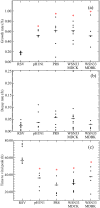A comparison of RSV and influenza in vitro kinetic parameters reveals differences in infecting time
- PMID: 29420667
- PMCID: PMC5805318
- DOI: 10.1371/journal.pone.0192645
A comparison of RSV and influenza in vitro kinetic parameters reveals differences in infecting time
Abstract
Influenza and respiratory syncytial virus (RSV) cause acute infections of the respiratory tract. Since the viruses both cause illnesses with similar symptoms, researchers often try to apply knowledge gleaned from study of one virus to the other virus. This can be an effective and efficient strategy for understanding viral dynamics or developing treatment strategies, but only if we have a full understanding of the similarities and differences between the two viruses. This study used mathematical modeling to quantitatively compare the viral kinetics of in vitro RSV and influenza virus infections. Specifically, we determined the viral kinetics parameters for RSV A2 and three strains of influenza virus, A/WSN/33 (H1N1), A/Puerto Rico/8/1934 (H1N1), and pandemic H1N1 influenza virus. We found that RSV viral titer increases at a slower rate and reaches its peak value later than influenza virus. Our analysis indicated that the slower increase of RSV viral titer is caused by slower spreading of the virus from one cell to another. These results provide estimates of dynamical differences between influenza virus and RSV and help provide insight into the virus-host interactions that cause observed differences in the time courses of the two illnesses in patients.
Conflict of interest statement
Figures






References
-
- Pavia AT. Viral Infections of the Lower Respiratory Tract: Old Viruses, New Viruses, and the Role of Diagnosis. Clin Infect Dis. 2011;52(S4):S284–S289. doi: 10.1093/cid/cir043 - DOI - PMC - PubMed
-
- Goka EA, Vallely PJ, Mutton KJ, Klapper PE. Single, dual and multiple respiratory virus infections and risk of hospitalization and mortality. Epidemiol Infect. 2015;143(1):37–47. doi: 10.1017/S0950268814000302 - DOI - PMC - PubMed
-
- Monto A, Sullivan K. Acute Respiratory Illness in the Community—Frequency of Illness and the Agents Involved. Epidemiol Infect. 1993;110(1):145–160. doi: 10.1017/S0950268800050779 - DOI - PMC - PubMed
-
- Caul EO, Waller DK, Clarke SKR, Corner BD. A Comparison of Influenza and Respiratory Syncytial Virus Infections among Infants Admitted to Hospital with Acute Respiratory Infections. J Hyg. 1976;77(3):383–392. doi: 10.1017/S0022172400055765 - DOI - PMC - PubMed
Publication types
MeSH terms
LinkOut - more resources
Full Text Sources
Other Literature Sources

